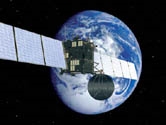 On Tuesday, 2 March, tension was replaced by exultation in KONGSBERG's space community. The Rosetta space probe was finally launched into outer space after several postponements. It has embarked on a long and perilous voyage, and it has to keep a date with a comet. KONGSBERG is part of the project.
On Tuesday, 2 March, tension was replaced by exultation in KONGSBERG's space community. The Rosetta space probe was finally launched into outer space after several postponements. It has embarked on a long and perilous voyage, and it has to keep a date with a comet. KONGSBERG is part of the project.
We have developed and delivered the mechanisms that rotate the huge solar panels on the Rosetta mother ship. "The solar panels provide power for all the instruments onboard, so the unit we delivered is what is called 'missile critical'; if it doesn't work, the entire mission is a wash", explains Aud Trondvold Fossdal, project manager for the delivery. The unit is called the Solar Array Drive Mechanism, and all reports thus far indicate that it is working perfectly.
The answer to the mystery of life? The Rosetta space probe is also called a 'comet chaser'. Its trek through the solar system will take more than 10 years, as it searches for a comet that may tell us something about the enigmatic origin of life. Once the space probe catches Comet 67/Churyumov-Gerasimenko in outer space, it will fly parallel to it for some time. Then the lander Philae will be deployed onto the comet. Together, the two craft will perform analyses on the comet as it moves towards the sun. Comets can be compared to big dirty snowballs made of ice, dust and rock particles. They contain organic matter that has remained unchanged since the solar system was formed more than 4.6 billion years ago. Research on comets is therefore research on our own origin.
An incredibly long voyage The voyage out to meet the comet is about five billion kilometres long. That is 20 times the distance to Mars! When launched on 2 March, Rosetta was a 'passenger' onboard an Ariane 5 booster rocket. The rocket took Rosetta into space at high speed, but that was not enough for Rosetta's journey. It has to gather gravitational force by orbiting around the Sun three times, then around Mars (in 2007) and three times past the Earth (in 2005, 2007 and 2009). It is scheduled to reach its target in 2014.
Formidable expertise The team Aud is responsible for has delivered similar equipment for the Mars Express. Their next job is the Venus Express, a satellite to be launched in 2005 and intended to explore our closest neighbour. The mechanisms were designed and developed by the space operations group at Kongsberg. Their work began in 1998 when a contract was signed with EADS-Astrium of the UK, which, in turn, has the European Space Agency (ESA) as its customer.
"We have a stable working group that has developed formidable expertise during these projects. It's fun to work with people that have so much enthusiasm and motivation", Aud tells us.
No margins of error Rosetta is one of the most challenging space projects ever. It involves a tremendous amount of complex navigation and the landing manoeuvres have to be executed automatically. There is absolutely no room for error. This means the product we delivered has been tested up and down countless times. A separate qualification model was tested, and since Rosetta's trek will be so long, special tests had to be run to determine how long the products will last.
"This is a fantastic, incredibly exciting project, and we will follow it closely in the years ahead. We are proud to be part of it", concludes Aud Trondvold Fossdal.

This group will be monitoring Rosetta's voyage through space closely for the next 10 years. L. to r.: Thor H. Sundquist, Aud Trondvold Fossdal, Sigmunn Strøm and Gudmund Thoen.